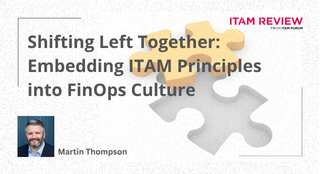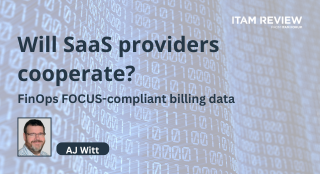ITAM Predictions 2024: Views from the industry
Last month we published our analysts’ predictions for what to expect in ITAM in 2024. Gazing into their crystal balls, Rich and AJ could see a year in which AI continues to mature and deliver innovations across all industries. With some SAM tools vendors having already launched AI-powered features in 2023, our industry will be no exception to this trend. If anything we should expect to see AI accelerate even faster in ITAM/SAM in 2024.
We saw some significant consolidation within ITAM and the broader IT industry at large in 2023. While it would be hard to match the scale and impact of Flexera’s surprise announcement that it was buying Snow, Rich expects consolidation to continue this year. Outside of ITAM and we also had acquisitions like IBM buying Apptio, while earlier-announce acquisitions, such as Broadcom’s acquisition of VMware, completed in 2023 and began to have a significant impact very quickly (see VMware stops selling perpetual licenses and As some VMware products come to an end some customers face 1200% price rises).
To keep the crystal ball gazing going, we reached out to people in the industry to hear some of their predictions and expectations for 2024.
FinOps and ITAM will continue to merge

Drawing on the results of its annual IT leaders survey, Piyush Patel, Technical Product & Solutions Marketing Manager at ServiceNow had a number of views on 2024. One of his points what the that bridge between Cloud FinOps and ITAM teams will continue to be built in 2024. According to the ServiceNow survey, only 5% of organizations have one team responsible for both FinOps and ITAM teams today. However, 55% predict that ITAM and FinOps will eventually be brought into a larger, unified organisation that will manage all asset types using specialized tools on an enterprise-wide platform. Let’s see how this trend takes shape in 2024.

Steve Tait, CTO at Snow Software, had similar views, but sees standardisation gathering pace this year. “Over the next year, IT asset management (ITAM) practices must start to partner with the FinOps discipline, if they have not done so already. As the FinOps Foundation works to establish the disciplines, tools and practices to manage the costs of the cloud fabric (IaaS and PaaS), ITAM practices must bring their tools and disciples to manage the cost of the licenses across the hybrid technology estate. Take SQL server as an example – this can be run on a desktop, server, IaaS, Server-in-the-Cloud, in a container or as an SQL managed services. Understanding this total license position across all hosting options and combining it with the fabric costs provided by FinOps is the only way to gain full visibility of IT costs.
We will continue to see FinOps grow in scale and influence [in 2024]. As Amazon (AWS) is now a core member of the FinOps Foundation, the Foundation can drive standardization across the hyperscalers.”
SaaS sprawl continues to be a big problem
For Steve, SaaS sprawl remains the greatest challenge for IT leaders in 2024. “Multiple empowered buying centres can now procure SaaS software with overlapping capability and without proper risk and data protection considerations. This will continue to drive up IT spend and risk presenting a large problem to CIOs.”
ITAM will further its role in sustainability
ITAM data will be key to improving the sustainability of organisations’ technology investments in 2024, says Victoria Barber, Senior. Director of Strategic Insights at SHI. “Supplementing traditional ITAM data with information from DEX tools will allow Intelligent Refresh (thanks Kevin English!), ensuring that we maximise the life of our endpoint assets. ITAM data will also be key to decisions made about datacenter investments and cloud strategy, optimizing workloads to minimize resource consumption. And both of these will also support cost optimization and employee effectiveness.
Vendor consolidation will cause headaches for resellers
Victoria’s other prediction is that as the vendor market consolidates, vendors will increasingly reduce the role of resellers in what has traditionally been a three-way relationship, by either working with their customers direct or transacting business through marketplaces. As a result end-user organisations may find that they lack the information they need to make sourcing decisions. “We’ve seen some predictions that this will result in an increase in demand for paid-for contract negotiation services, but less attention paid to the need to ensure appropriate software licensing. There is a distinct possibility that if this doesn’t lead to an increase in demand for licence advisory and proactive Software Asset Management services, then it may lead to an increase in audit failure and demand for reactive SAM services to clean up the mess.”
ITAM must not lose sight of its foundational role in everything that IT (and business) does

In something of a Call to Arms for ITAM, Victoria reminds us that ITAM is foundational to pretty much everything that IT and business wants to achieve. “While I’m no longer focused purely on ITAM in my current role at SHI, what I’ve found over the past three-and-a-bit years of having a wider remit is that it has given me some perspective.”
“In the age of digital business, everyone is dependent on technology and they’re often unaware of the complexity behind the systems they use. So of course, as ITAM professionals have been saying for years (decades!) ITAM is the foundation for everything we do in IT – and potentially in business. I frequently find myself reminding my colleagues or customers that good ITAM is the key to the success of whatever particular initiative or technology we are discussing. And that much like cybersecurity and sustainability, it needs to be built into everything we do in tech (and by extrapolation, in business) by default. In fact, if we’re building in cybersecurity and sustainability, surely we have to already have the ITAM capabilities built in?”
Victoria acknowledges that none of that is new – and often that’s the frustration for those of us who have been working in the ITAM space for a long time. It sometimes feels as if we’re repeating ourselves over and over. “The conversation about ITAM being a discipline or capability and NOT a project is, unfortunately, something that still needs to be repeated regularly. But on the plus side, it keeps ITAM professionals in a job!”
These words are worth repeating. Are you prepared to make an even bigger case for ITAM in 2024? We must never lose sight of its foundational role. So let’s keep banging the ITAM drum!
Can’t find what you’re looking for?
More from ITAM News & Analysis
-
Broadcom vs Siemens AG - A Brewing Storm
The ongoing legal battle between VMware (under Broadcom ownership) and Siemens is yet another example of why ITAM goes far beyond license compliance and SAM. What might, at first glance, appear to be a licensing dispute, ... -
Shifting Left Together: Embedding ITAM into FinOps Culture
During one of the keynotes at the FinOps X conference in San Diego, JR Storment, Executive Director of the FinOps Foundation, interviewed a senior executive from Salesforce. They discussed the idea of combining the roles of ... -
Addressing the SaaS Data Gap in FinOps FOCUS 2.1
I recently reported on the FinOps Foundation’s inclusion of SaaS and Datacenter in its expanded Cloud+ scope. At that time, I highlighted concerns about getting the myriad SaaS companies to supply FOCUS-compliant billing data. A couple ...
Podcast
ITAM training
Similar Posts
-
Broadcom vs Siemens AG - A Brewing Storm
The ongoing legal battle between VMware (under Broadcom ownership) and Siemens is yet another example of why ITAM goes far beyond license compliance and SAM. What might, at first glance, appear to be a licensing dispute, ... -
Shifting Left Together: Embedding ITAM into FinOps Culture
During one of the keynotes at the FinOps X conference in San Diego, JR Storment, Executive Director of the FinOps Foundation, interviewed a senior executive from Salesforce. They discussed the idea of combining the roles of ... -
Addressing the SaaS Data Gap in FinOps FOCUS 2.1
I recently reported on the FinOps Foundation’s inclusion of SaaS and Datacenter in its expanded Cloud+ scope. At that time, I highlighted concerns about getting the myriad SaaS companies to supply FOCUS-compliant billing data. A couple ... -
The Future of ITAM
As an ITAM Industry Analyst, I’m often asked what ITAM’s future looks like. This can be a tough question to answer because when it comes to the future, there are endless possibilities. Often, it seems, some ...




